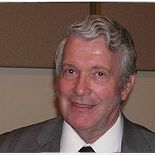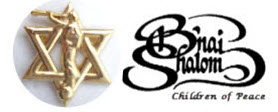Bnai Shalom - Jews and Latter-day Saints, and Friends
Fellowship, Food, Jewish/LDS Inspiration, Music
Spring 1998 - Dr. LeGrand L Baker
From the Introduction Handout

LeGrand Baker was born on his grandfather’s cattle ranch in Boulder, Utah. He grew up in Utah Valley, served an LDS mission in England, and graduated from BYU. He attended the University of Wisconsin at Madison, where he earned a Masters and Ph.D. in American history, focusing on the period of the American Revolution and the writing of the Constitution. After graduation, he taught at the University of Arkansas before returning to BYU as a faculty member in 1974.
LeGrand was Curator of the Wells Freedom Archives and Adjunct Professor of History at BYU, teaching American Constitutional History from 1974 to 2004. He taught in the LDS Institute at Madison, has taught many courses in history and religion at BYU., and has published articles in The Improvement Era, The Ensign, and elsewhere.
LeGrand Liston Baker passed away in 2018. His website and writings live on.
At this gathering, LeGrand presented the theme of the book he authored with Stephen D Ricks (see bottom of this page). The following was on his handout:
"After archaeologists found the great temple libraries which had been written on clay tablets and buried with the destroyed cities of the ancient Near East, Hermann Gunkel, a Biblical scholar who could read the cuneiform tablets, made a startling discovery. He said that some of the Biblical Psalms were the actual text of the long forgotten, but, originally, the most important of all ancient Israelite religious celebrations — the twenty-two day New Year’s festival which incorporated the Day of Atonement and concluded with the Feast of Tabernacles.
Continue with More:
"Subsequent scholars expanded his idea, saying that many, probably all, of the Psalms were originally composed to be sung as a part of the festival’s annual presentation of a drama in which enacted the stories of the Council in Heaven; the war in heaven; the creation and Adam and Eve in the Garden; their expulsion, and the continuation of Adam’s kingship and priesthood through the Patriarchs, Moses, David, and on to the then present king.
"The object and conclusion of this great festival was the re-making of Israel’s priesthood and kingship covenants with Jehovah, and re-enthronement of Jehovah as Israel’s King; and with the coronation (or re-coronation) of the then reigning monarch as king of Israel (or after the death of Solomon, as king of Judah ).
"Scholars have pointed out that the pattern of the festival drama and of its enthronement ceremonies is found in Hebrew literature, such as the Book of Enoch, and Revelation in the New Testament. But to Latter-day Saints, one of the most significant examples of the repetition of that pattern is found in Third Nephi.
"There the events of the Saviour’s coming, and his teachings, follow the pattern of the ancient Israelite New Year’s festival so closely that it appears Mormon deliberately used the enthronement sequence as the outline of his story. Presumably, he did this in order to testify that when Christ came to America he came as its legitimate King; and perhaps also to show that when the Saviour appointed Nephi to be head of the church and of the new theocratic government, he followed the pattern already established for the kings of ancient Israel.
Dr. Baker described the events and the significance of the New Year’s festival, and showed its links with the Book of Mormon, and especially with Third Nephi.
His book, coauthored with Dr. Stephen D. Ricks
By the author: The more I studied the Book of Mormon, the more I realized that it is an ancient Israelite temple text. ... every sermon in the book is founded upon the Nephite temple experience and on the Psalms that were much of the ceremonial foundation of Nephite theology.
The focal point of their most important annual ceremony was Psalms 24. That Psalm was sung as part of the ancient coronation ceremony, when the earthly king was adopted as son and heir of Jehovah and was anointed priest and king. In conjunction with the king’s anointing, every man in the congregation was symbolically adopted as a child of God and anointed as a sacral king and priest. As such, each was symbolically invited to come into the Holy of Holies where God was.
From the Forward by Dr. Ricks
The 24th Psalm as an Invitation to come to the Temple
Ancient Israelite religion breathes a different spirit from that observed by the remnant of the Israelites — the Jews who returned to Jerusalem and Judea after the Babylonian exile. The Psalms are a mirror of that earlier religion. The Psalms reflect an interest in 1) temple; 2) kingship (of God and man); 3) Messiah; 4) creation; and 5) priesthood. With somewhat different shades of emphasis, the Book of Mormon also shows an interest in the same things.
Psalm 24 provides in brief compass, a wonderful example of the themes of the Psalms: creation, the kingship of God, and temple. The Psalm (vs. 1-2) begins with God's creation of the earth, following the most venerable traditions of ancient cosmology (the earth is founded it “upon the seas,” established “upon the rivers”). Creation is central to the worship of ancient temples and other sacred places. “Ancient temples,” writes Hugh Nibley, “rehearsed the story of the creation, and the establishment of mankind and the royal government of God upon this earth.”
The ancient Babylonian temple was the site of the Akitu Festival that “served to reestablish the proper pattern of nature, with order prevailing over chaos, and to reaffirm the gods, the king, and his subjects in their respective roles in the cosmic order”2 during which a priest was instructed to read the Enuma Elish, the Babylonian creation story that retold the combat between the gods and Apsu and Tiamat, the personalized powers of chaos and the victory of Marduk over them, followed by his creation of the world and a hymn extolling his kingship. In the later parts of the festival the victory of Marduk over Tiamat was ritually reenacted. While there is some uncertainty about the use of the Genesis creation text in the Jerusalem Temple before the exile, there is compelling evidence for it.
| Your contribution helps ! |
